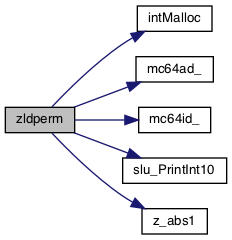Finds a row permutation so that the matrix has large entries on the diagonal. More...
#include "slu_zdefs.h"
Include dependency graph for zldperm.c:

Functions | |
| int_t | mc64id_ (int_t *) |
| int_t | mc64ad_ (int_t *job, int_t *n, int_t *ne, int_t *ip, int_t *irn, double *a, int_t *num, int *cperm, int_t *liw, int_t *iw, int_t *ldw, double *dw, int_t *icntl, int_t *info) |
| int | zldperm (int job, int n, int_t nnz, int_t colptr[], int_t adjncy[], doublecomplex nzval[], int *perm, double u[], double v[]) |
Detailed Description
Copyright (c) 2003, The Regents of the University of California, through Lawrence Berkeley National Laboratory (subject to receipt of any required approvals from U.S. Dept. of Energy)
All rights reserved.
The source code is distributed under BSD license, see the file License.txt at the top-level directory.
-- SuperLU routine (version 4.0) -- Lawrence Berkeley National Laboratory. June 30, 2009
Function Documentation
◆ mc64ad_()
| int_t mc64ad_ | ( | int_t * | job, |
| int_t * | n, | ||
| int_t * | ne, | ||
| int_t * | ip, | ||
| int_t * | irn, | ||
| double * | a, | ||
| int_t * | num, | ||
| int * | cperm, | ||
| int_t * | liw, | ||
| int_t * | iw, | ||
| int_t * | ldw, | ||
| double * | dw, | ||
| int_t * | icntl, | ||
| int_t * | info | ||
| ) |
◆ mc64id_()
◆ zldperm()
| int zldperm | ( | int | job, |
| int | n, | ||
| int_t | nnz, | ||
| int_t | colptr[], | ||
| int_t | adjncy[], | ||
| doublecomplex | nzval[], | ||
| int * | perm, | ||
| double | u[], | ||
| double | v[] | ||
| ) |
Purpose
=======
ZLDPERM finds a row permutation so that the matrix has large
entries on the diagonal.
Arguments
=========
job (input) int
Control the action. Possible values for JOB are:
= 1 : Compute a row permutation of the matrix so that the
permuted matrix has as many entries on its diagonal as
possible. The values on the diagonal are of arbitrary size.
HSL subroutine MC21A/AD is used for this.
= 2 : Compute a row permutation of the matrix so that the smallest
value on the diagonal of the permuted matrix is maximized.
= 3 : Compute a row permutation of the matrix so that the smallest
value on the diagonal of the permuted matrix is maximized.
The algorithm differs from the one used for JOB = 2 and may
have quite a different performance.
= 4 : Compute a row permutation of the matrix so that the sum
of the diagonal entries of the permuted matrix is maximized.
= 5 : Compute a row permutation of the matrix so that the product
of the diagonal entries of the permuted matrix is maximized
and vectors to scale the matrix so that the nonzero diagonal
entries of the permuted matrix are one in absolute value and
all the off-diagonal entries are less than or equal to one in
absolute value.
Restriction: 1 <= JOB <= 5.
n (input) int
The order of the matrix.
nnz (input) int
The number of nonzeros in the matrix.
adjncy (input) int*, of size nnz
The adjacency structure of the matrix, which contains the row
indices of the nonzeros.
colptr (input) int*, of size n+1
The pointers to the beginning of each column in ADJNCY.
nzval (input) doublecomplex*, of size nnz
The nonzero values of the matrix. nzval[k] is the value of
the entry corresponding to adjncy[k].
It is not used if job = 1.
perm (output) int*, of size n
The permutation vector. perm[i] = j means row i in the
original matrix is in row j of the permuted matrix.
u (output) double*, of size n
If job = 5, the natural logarithms of the row scaling factors.
v (output) double*, of size n
If job = 5, the natural logarithms of the column scaling factors.
The scaled matrix B has entries b_ij = a_ij * exp(u_i + v_j).
Here is the call graph for this function:
